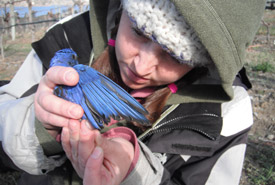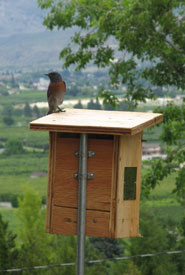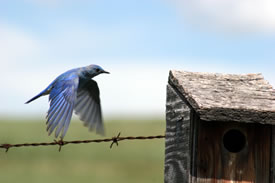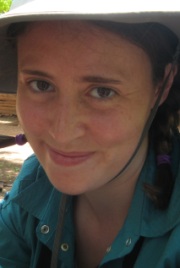There's no place like home

Catherine Dale with bluebird (Photo by Angela Boag)
“The bluebird carries the sky on his back.” ~ Henry David Thoreau
It seems to be an immutable law of nature photography (at least in my experience) that anything mobile will move the second you’ve gotten your camera ready, leaving you standing forlornly with your lens pointed at empty space.
But on this particular summer morning, I seemed to be witnessing an exception to this law. As two hikers scrabbled through their backpacks for cameras, a male western bluebird sat calmly on top of the nearby nest box, singing his heart out — completely unperturbed by his audience.
From my perch beside the trail, I watched the hikers rifling through their bags somewhat frantically. Although I’m very familiar with "perfect shot" panic. In this case I was pretty sure the would-be photographers would have no trouble snapping their photo — since the bluebird in question was in fact my wooden decoy bird, Webster. I had set him up on the box about 20 minutes earlier, hoping to lure in the bluebird that actually owned it. Apparently neither hiker had noticed the clip attaching Webster to the box — or the speaker below, broadcasting bluebird song.

Western bluebird (Photo by Catherine Dale)
As the hikers finally pulled out their cameras, I thought about explaining the situation but somehow it just seemed mean to spoil their excitement. A few minutes later, as they continued on their way, their conversation floated back to me: “That was amazing! I can’t believe he sat so still. I love bluebirds; they’re so beautiful. That just made my day!”
Everybody loves bluebirds.
One of the first things you learn as a science student is to be wary of making absolute statements. When you say something is "always" true, or the "the cause" of something, you had better be able to back it up.
And yet, even though I am not willing to go out and interview the 7.2 billion people in the world to determine their opinion on bluebirds, I’m still comfortable making this statement: everybody loves bluebirds. They are, in fact, inherently lovable — charismatic, highly visible little birds with beautifully vivid plumage, associated with happiness, spring and the land somewhere over the rainbow.
I have to admit, when I decided to focus my PhD research on bluebirds, I didn’t realize just how much people love them. I quickly discovered that there are both upsides and downsides to working with a group of birds so universally beloved.
To be honest, sometimes it made things considerably more complicated. For one thing, it meant that people tended to be very interested in what I was doing. While this is mostly a good thing, it can be difficult to focus on answering questions and doing fieldwork simultaneously. For another, people were often very protective of "their" birds, and reluctant to allow me to capture and band them — a totally understandable attitude, but one that sometimes made my work a bit harder.
All ornithologists are aware that banding is a stressful experience for a bird. Although we try to mitigate that stress as much as possible, being ensnared by a net, grabbed by a giant hand and then handled, poked, and measured...well, it just can’t be that much fun. Ornithologists do what we do because being able to identify individual birds gives us important insights into behaviour and ecology that would otherwise be impossible. Ultimately, banding birds may provide us with information that benefits the species (for example, by informing management plans) — but we are all very aware that no individual bird ever benefits from being banded.
But while public interest in bluebirds occasionally made my life a bit more difficult, there were also many upsides to working with such an iconic group of birds: chief among them, having a species to study at all.
Perhaps one of the main reasons that people love bluebirds is that they are, relatively speaking, easy to see. They are dwellers of disturbed areas. They love the long forest edges and wide open fields created by agriculture; unlike many other bird species, human-wrought habitat changes were largely beneficial for them. However, in the late 1960s and early 1970s, naturalists began to notice a troubling trend: a persistent decline in bluebird populations.

Mountain bluebird flying to box (Photo by Allison Haskell)
Although bluebirds forage mainly in open areas, they build their nests within cavities in trees. All three species of bluebird are secondary cavity nesters — meaning that, while they need cavities for nesting, they do not create those cavities themselves. Instead, they depend on finding holes created and abandoned by other species of cavity nesters such as woodpeckers.
So when bluebird numbers began to decline, people wondered if maybe there simply weren’t enough cavities for them to nest in anymore. But if that was the problem? What had caused the decrease in available nesting cavities? The answer was simple: while the actual number of cavities available was staying the same, the competition to use them was likely getting increasingly fierce — thanks mainly to the introduction of a number of invasive cavity nesting species such as the European starling and the house sparrow to North America.
Concerned citizens were determined to tackle the problem. Getting rid of the advancing hordes of invasive cavity nesters was virtually impossible, so they approached the problem from the other direction, by building and installing artificial nest boxes. These boxes were designed to exclude some of the larger competing species (such as starlings), and were carefully positioned away from sources of food for house sparrows, to decrease their interest in the boxes.
As public interest in the plight of the bluebirds grew, enthusiastic citizen scientists began to establish nest box trails across the continent, and populations of all three bluebird species began to rebound. In 1978, scientist Lawrence Zeleny enlisted the help of the Audubon Society to found the North American Bluebird Society (NABS) — an organization that continues to actively promote the conservation of bluebirds and other cavity nesters today.
Currently many populations of all three bluebird species are stable or increasing, thanks in large part to NABS and its network of citizen scientists. Every spring, these citizen scientists maintain and monitor thousands of bluebird nest boxes across North America. Volunteers like 91-year-old Al Larsen (the subject of "Bluebird Man," a recent documentary by wildlife filmmakers Wild Lens) spend many hours each year gathering detailed information on box usage and nesting success of bluebirds and the many other species of cavity nesters that use the boxes; ultimately producing huge amounts of data on a much larger scale than any single researcher ever could.
The bluebird recovery story is an inspiring tale of grassroots conservation success — a win for the birds, but also a win for the people who continue to put so much effort into protecting them. Although I encountered a few challenges working with this "poster species," I don’t regret for a second choosing to study bluebirds for my PhD.
Getting to know the bluebirder community gave me the opportunity to work with some of the kindest and most generous people I’ve ever met — people who went out of their way to help and support me. Without them, my project would not have been a success. But more than that, I found that I loved watching the bluebirds too. Even on the most frustrating field days, they made me smile — partly because of their charisma, but also because they are living proof that sometimes, we can make a difference.
This post originally appeared on Dispatches from the Field.


